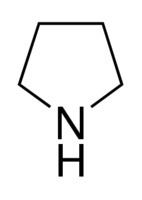Formula C4H9N Boiling point 87 °C | Density 866 kg/m³ Appearance Clear colorless liquid | |
 | ||
Related Nitrogen heterocyclic compounds | ||
Pyrrolidine, also known as tetrahydropyrrole, is an organic compound with the molecular formula (CH2)4NH. It is a cyclic secondary amine, also classified as a saturated heterocycle. It is a colourless liquid that is miscible with water and most organic solvents. It has an ammonia-like, but characteristic odor. In addition to pyrrolidine itself, many substituted pyrrolidines are known.
Contents
Synthesis and occurrence
Pyrrolidine is produced by treatment of 1,4-butanediol with ammonia over an oxide catalyst.
Many modifications of pyrrolidine are found in natural and synthetic chemistry. The pyrrolidine ring structure is present in numerous natural alkaloids such as nicotine and hygrine. It is found in many drugs such as procyclidine and bepridil. It also forms the basis for the racetam compounds (e.g. piracetam, aniracetam). The amino acids proline and hydroxyproline are, in a structural sense, derivatives of pyrrolidine.
Reactions
Pyrrolidine is a base. Its basicity is typical of other dialkyl amines. Relative to many secondary amines, pyrrolidine is distinctive because of its compactness, a consequence of its cyclic structure.
Pyrrolidine is used as a building block in the synthesis of more complex organic compounds. It is used to activate ketones and aldehydes toward nucleophilic addition by formation of enamines:
